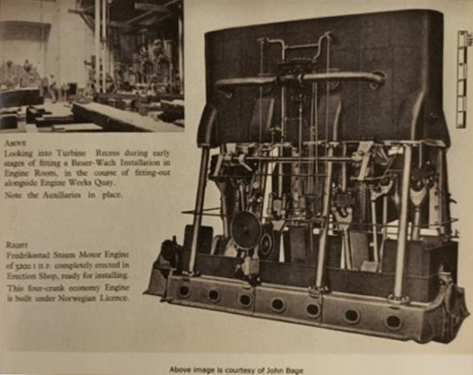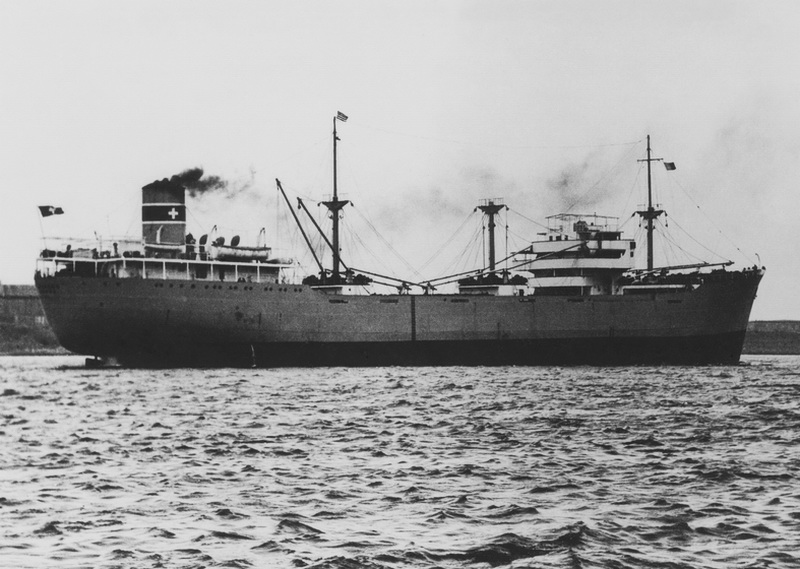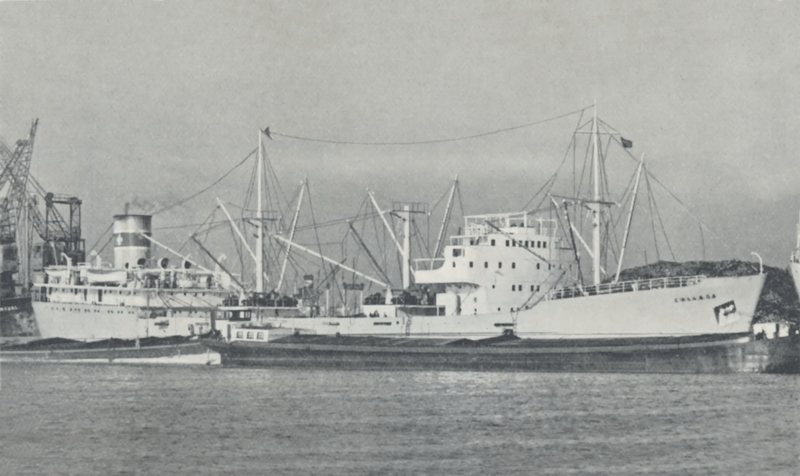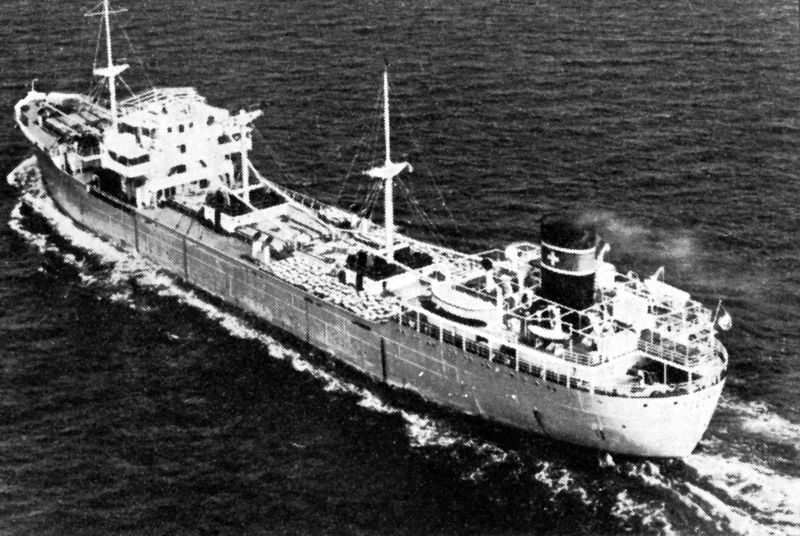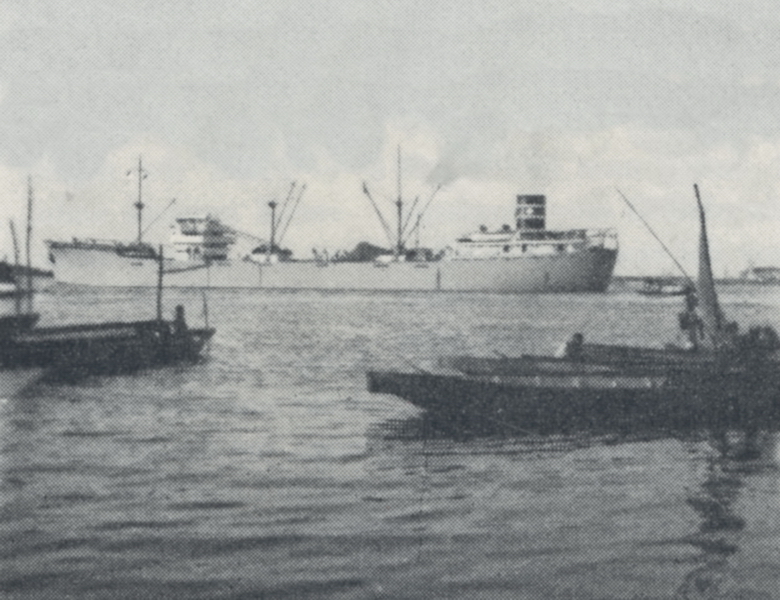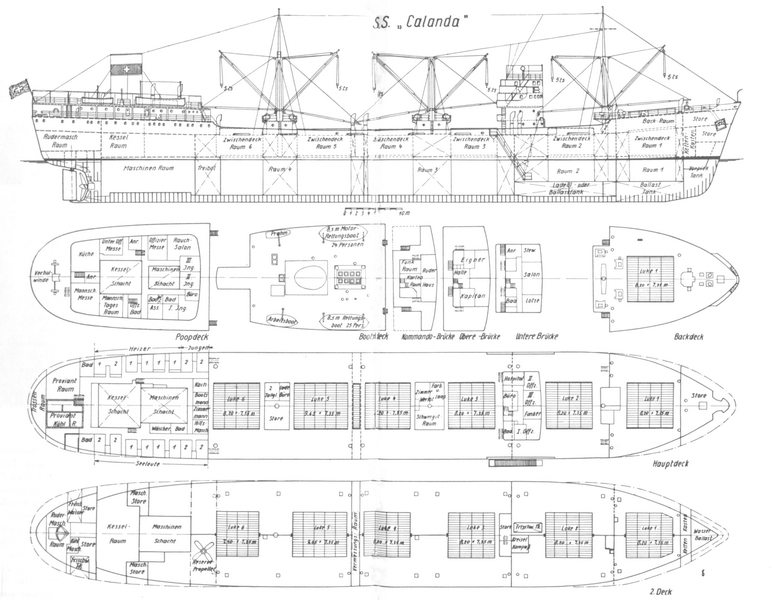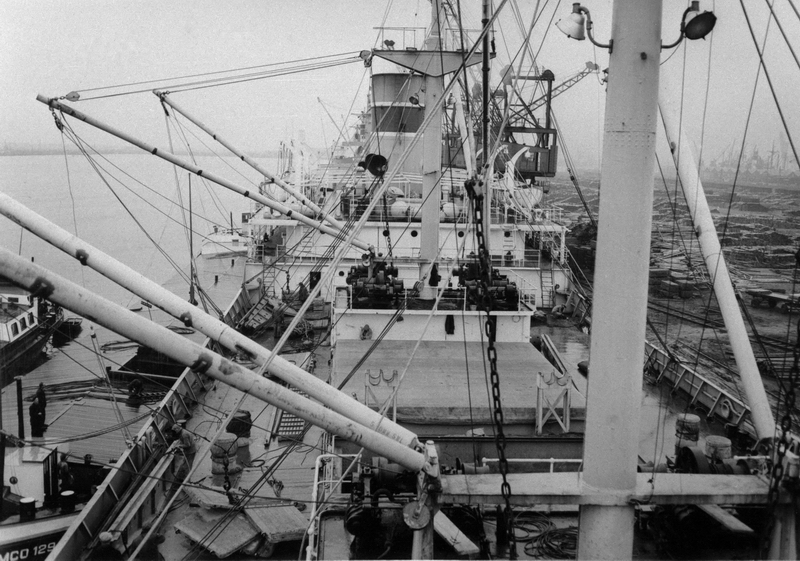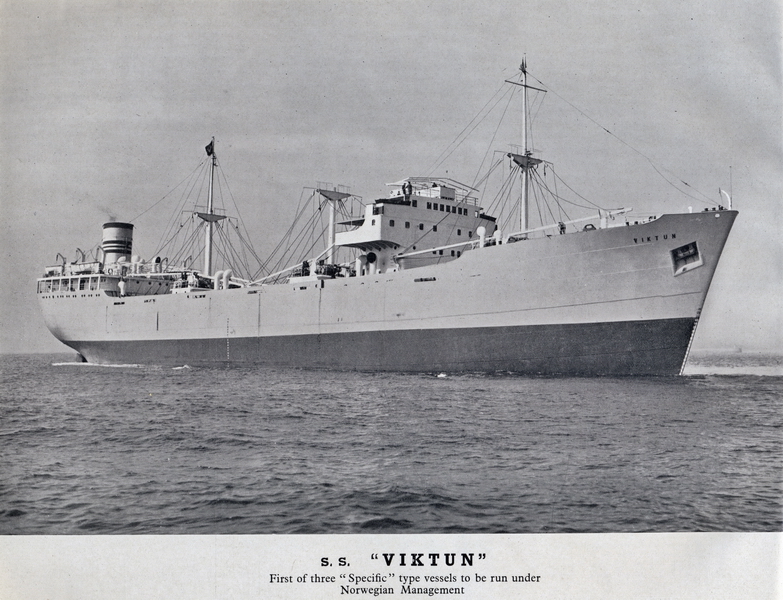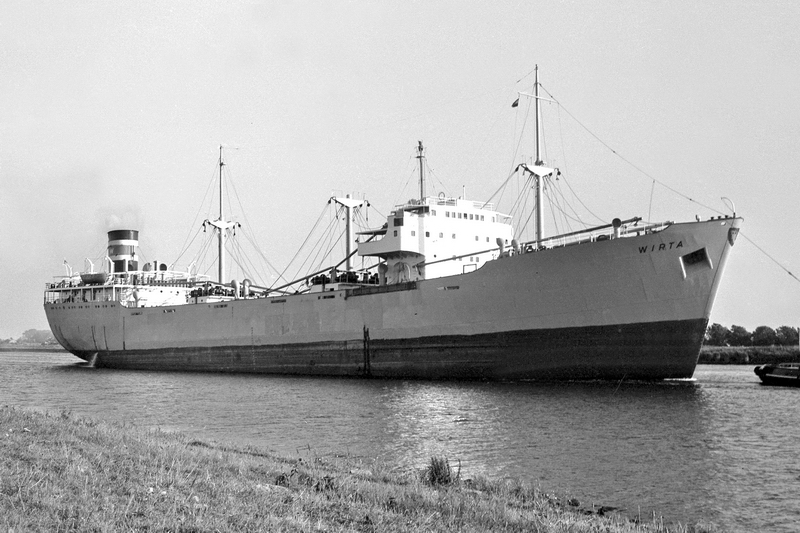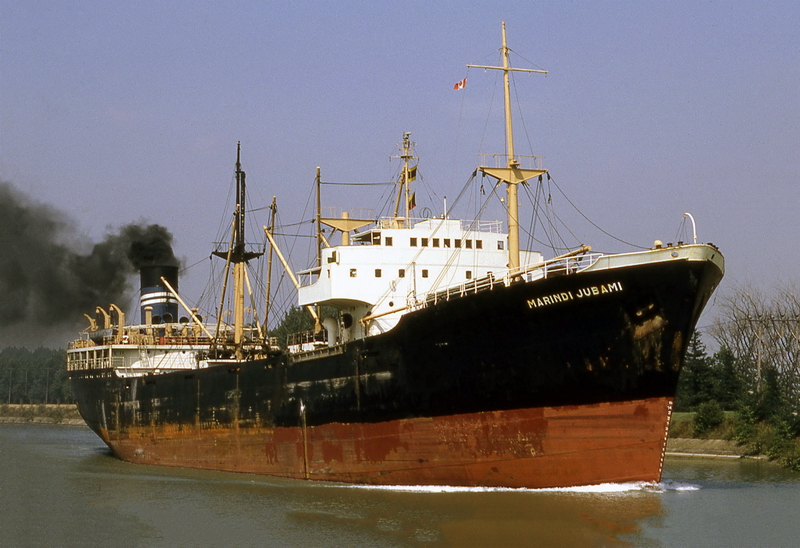
CALANDA
Lloyd's Register No.: 5392276
Schiffstyp / Ship's type: Dampf -Stückgutfrachter / Steam - General Cargo Vessel
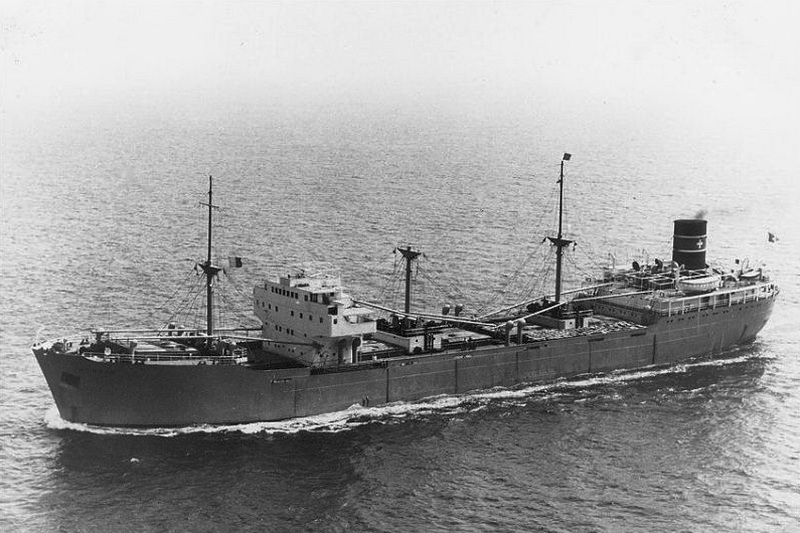
![]()
Bau / Construction
| Bauwerft / Shipyard: | John Readhead & Sons Ltd. West Yard, South Shields | ||
| Bau Nr. / Hull / Yard No.: | 557 | Baujahr / Year of built: | 1948 |
| Kiellegung / Keel laying: | 00.00.1947 | Stapellauf / Launching: | 26.01.1948 |
| Ablieferung / Delivery: | 00.05.1948 | ||
![]()
Reeder - Manager / Shipping company - Manager
| Eigner / Registered owner: | Schweizerische Reederei A.G. (Swiss Shipping Co. Ltd.), Basel | ||
| Reeder / Shipping Company (Manager): | Alpina Transport & Affrêtements S.A., Antwerpen | ||
| Tech. Management / Technical Mgmt.: | Alpina Transport & Affrêtements S.A., Antwerpen | ||
| Management von / from: | 03.11.1951 | Management bis / until: | 22.12.1955 |
| Registerhafen / Homeport: | Basel | Flagge / Flag: | Switzerland (CHE) |
| Rufzeichen / Call sign: | HBDN | CH-Register-Nr. / Official No.: | 36 |
| Registrier Datum / Date: | 03.11.1951 | Register Streichung / Deletion: | 22.12.1955 |
| Verbleib / Fate: | Verkauft nach Finnland / Sold to Finland | ||
![]()
Vermessung / Tonnage
| BRZ / GT: | 4'783 | Länge / Length: | 123.69 | Meter | ||
| NRZ / NT: | 2'677 | Breite / Breadth: | 18.40 | Meter | Passenger: | - |
| DWT: | 7'850 | Tiefgang / Draft: | 7.12 | Meter | Besatzung / Crew: | 37 |
| Lightship tons: | n.a. | Tiefe / Depth: | 11.46 | Meter | ||
| Ladewinden / | Cargo winches: 12 Dampf / Steam | |||||
| Ladegeschirr / Cargo gear: | 2 10-ton & 10 5-ton SWL (Safe Working Load) Ladebäume / Derricks | |||||
![]()
Maschine / Machinery
| Maschinen-Typ / Engine type: | Double expansion 4-cylinder steam engine Fredrikstad Mekaniske Verkstad (FMV) |
| Maschinenhersteller / Engine builder: | J. Readhead & Sons, South Shields |
| Leistung / Power: | 2'300 PS / HP |
| Geschwindigkeit / Speed: | 10.5 Knoten / Knots |
| Antrieb / Propulsion: | 1 Festpropeller / Fixed blade propeller |
![]()
Registrierte Schiffsnamen / Registered ship's names
| Datum / Date | Schiffsname / Name | Heimathafen / Homeport |
| 00.05.1948 | Viktun | Panama |
| 03.11.1951 | CALANDA | Basel |
| 22.12.1955 | Wirta | Helsinki |
| 00.01.1965 | Marindi Jubami | Monrovia |
| 00.00.1969 | Karina I | Cartagena |
| 15.10.1973 | Ina | Cartagena |
| Verbleib des Schiffes / Fate of vessel: | 19.12.1973 im Schlepp gesunken / In tow taking in water and sank |
![]()
Berichte
Leventina Heft Nr. 9 November 1951 Bericht: Alfred Lüssi
Leventina Nr. 11 - 12. 1952 Tagebuch Afrikafahrt R. Hitz (I)
Leventina Nr. 1 - 2. 1953 Tagebuch Afrikafahrt R. Hitz (II)
Leventina Nr. 5 - 6 1955 Aequatortaufe CALANDA 22. Januar 1955
Reederei interner Bericht über mögliche Motorisierung / Verkauf (September / Oktober 1955)
Leventina Nr. 1 Jan. - 2 Feb. 1956 Bericht über den Verkauf von S/S CALANDA
![]()
Schiffsgeschichte

Gebaut 1948 bei J. Readhead & Sons Ltd., South Shields, England als VIKTUN für Tanker Corporation, Panama (Management: Johan Rasmussen*) & Co., Sandefjord). Die norwegischen Eigner registrierten den Dampfer unter Panama Flagge (Rufzeichen: unbekannt). Panamesische Tonnage BRT: 4'689, NRT: 2'642, DWT: 7'850. Im Herbst 1951 angekauft durch die Schweizerische Reederei AG (Swiss Shipping Co. Ltd.), Basel und in Hamburg übernommen. Umbenannt in CALANDA (2. Schiff dieses Namens) und am 03.11.1951 unter Schweizer Flagge registriert (Register Nr.: 36, Rufzeichen: HBDN). Den Betrieb übernahm das Büro in Antwerpen, Alpina Transport & Affrêtements S.A. Die CALANDA war der letzte Dampfer den die Schweizerische Reederei in Dienst stellte, später folgten nur Motorschiffe. Alte Schweizer Seeleute erzählten, das Schiff (zusammen mit der GENERAL DUFOUR) wären zuerst als Walöl-Tanker geplant gewesen und nachher zum Frachter umgebaut worden. Unser Bekannter Dave Waller (Betreiber der Webseite www.tynebuiltships.co.uk) konnte diese Pläne nicht bestätigen, die Bauspezifikation wurde für ein Frachtschiff entworfen. Er hatte jedoch eine mögliche Erklärung für die Entstehung dieses Gerüchtes. Johan Rasmussen war Eigner der Viking Whaling Co. und der Vestfold Whaling Co. in London. Die Taufpatin der VIKTUN war die Ehefrau von W.G.M. Hamilton, Direktor der Vestfold Whaling Company, London. Der Antrieb erfolgte mit einer 4-zylindrigen Dampfmaschine mit doppelter zweifach-Expansion, d.h. mit 2 Hochdruck- und zwei Niederdruckzylindern von je 450 mm und 1080 mm Durchmesser. Der Kolbenhub betrug 985 mm. Die Leistung betrug 3160 PSi (indizierte PS). Diese Dampfmaschine baute die Werft unter Lizenz von der Fredrikstad Mekaniske Verkstad (FMV), Fredrikstad, Norwegen.
Die Dampfhauptmaschine hatte 4 Zylinder und 4 Kurbelwangen (Courtesy of Dave Waller, www.tynebuiltships.co.uk) Dampf lieferten 2 ölgefeuerte Foster Wheeler D-Type Wasserrohrkessel, Dampfdruck 220 psi (15,5kg/cm2) und die Dampftemperatur betrug 600°F (315°C), somit überhitzter Dampf. Gleichstrom lieferten zwei Dampfgeneratoren von 30 kW und ein Hafendiesel von 15 kW, also sehr bescheiden, denn der ganze Hilfsbetrieb in der Maschine und auf Deck war dampfbetrieben. Die erste Reise führte mit einer Ladung Zement von Hamburg, Antwerpen über Teneriffe nach Recife und Paranagua, für die Rückreise wurde eine volle Ladung Eisenerz in Vitoria für Antwerpen an Bord genommen. In Recife besuchte der Schweizer Konsul den Dampfer und schrieb einen kurzen Brief an das EPD in Bern und an das Seeschifffahrtsamt in Basel. Der Chief Engineer brauchte Unterstützung nach der Suche nach einem geeigneten Betrieb an Land, der zwei ausgebrannte Kurbellager der Hauptmaschine neu ausgiessen und bearbeiten konnte, diese Aktion wurde auch erfolgreich abgeschlossen. In der Maschine lag einiges im Argen und hielt die Maschinencrew auf Trab. Offenbar hatten die Norweger den Dampfer nicht im besten Zustand übergeben. Gemäss Kapitän Müller, ein Deutscher, bestand die Besatzung aus 35 Mann, davon 21 Schweizer. Auch fügte er bei, das gegenseitige Einvernehmen an Bord wäre sehr gut. Mehrere in Recife ansässige Schweizer, die Leute von der CALANDA an Land angetroffen hatten, vermeldeten ebenfalls einen besten Eindruck. Die Besatzung erhielt in Recife keine Post aus der Heimat und zum Schluss regte der Konsul an, die Reederei möge in Zukunft die Schiffspost per Luftpost nach Übersee schicken, denn die gewöhnliche Post mit dem Postdampfer würde ungefähr 4-6 Wochen viel zu lange dauern. Die zweite Reise führte nach Buenos Aires und Montevideo, dann über den Südatlantik nach Ghana und Nigeria. Im Nigerdelta fuhr sie auch den Sambreiro River hoch nach Abonema (etwa 50-60 km flussaufwärts), eine Reede und ein Handelsposten aus kolonialen Zeiten, die aber heute kaum mehr von Seeschiffen angelaufen wird. Es folgten Reisen nach Brasilien, Westindien, US-Ostküste, St. Lorenz Golf, Mittelmeer (bis Beirut und Port Said). Auf ihrer letzten Reise besuchte die CALANDA noch den Persischen Golf, Indien und Japan. Kapitän Louis Schwarz fuhr am Ende der Zeit unter Schweizer Flagge ungefähr zwei Jahre auf dem Schiff und arbeitete sich vom Deckhand zum AB (Vollmatrose) hoch. Der Dampfer war bei der Mannschaft äusserst beliebt. Unten ein paar Erinnerungen von Louis Schwarz. Im Frühjahr 1954 charterte ein Papierhersteller in Neufundland die CALANDA um Papierrollen für Zeitungen von Botwood, Neufundland, Kanada an die Ostküste und den Golf der USA zu bringen. Auf der ersten Reise konnte Botwood wegen dem Eis noch nicht angelaufen werden, es musste im eisfreien St. John’s geladen werden. Botwood ist ein kleines Städtchen am Exploits River ungefähr 50 km vom Meer entfernt im Norden von Neufundland. Die Firma wollte ein Schiff mit rechteckigen Laderäumen und ohne Wellentunnel um die Papierrollen besser und schneller stauen zu können, wobei eine Unmenge Holz verbraucht wurde. Auf der zweiten Reise, jetzt nach Botwood, musste der Dampfer auf dem Fluss eine Eisbarriere durchfahren, dabei schlug ein grosses Eisstück ein Loch in die Forepeak, von ungefähr 20 x 30 cm. Glücklicherweise gelang es dem Bootsmann und dem Chippy (Zimmermann) den Schaden temporär mit einer Zementbox zu reparieren, bis in der nächsten Werftzeit der Schaden permanent behoben wurde. Im Februar 1955 löschte die CALANDA Kohle in Buenos Aires, die in Dünkirchen geladen wurde, als plötzlich beim hintersten Laderaum Schweröl aus dem Greifer lief. Was war geschehen? Nach der Werftzeit in Antwerpen, bunkerte man in Dünkirchen auch Schweröl. Leider waren einige Mannlochdeckel nicht richtig verschraubt, so dass das Schweröl vom Doppelbodentank in den Laderaum überfliessen konnte. Die Maschinisten behaupteten jedoch, das Schweröl wäre aus einem korrodierten Rohr der Tankentlüftung ausgelaufen. Im Sommer 1955 brachte die CALANDA Klinker für das neue Zementwerk nach Santiago de Cuba, dann Kriegsmaterial von den USA nach Bandar Shapur (heute: Bandar-e Emam Khomeyni) und Basrah am Shatt-al-Arab im Persischen Golf. In Ballast fuhr sie nach Bhavnagar, Indien um Erz für Japan zu laden. Hier ging eine Schubstange der Hauptmaschine in die Brüche und musste ersetzt werden. Eine Ersatz-Schubstange war nicht an Bord, so musste eine neue Schubstange in England fabriziert und dann per Flugzeug nach Bombay spediert werden. In der Zwischenzeit segelte die CALANDA mit reduzierter Maschinenleistung auf die Reede von Bombay, wo nach ungefähr einem Monat die neue Schubstange Ende August 1955 eintraf und eingebaut werden konnte. Noch ein erwähnenswertes Detail, niemand vom Maschinendepartement sprach damals Englisch, ausser dem 3. Maschinisten Gerhard Baumberger (später lange Zeit Inspektor bei Keller Shipping), der dann zwischen den Leuten von Land und den Ingenieuren übersetzen musste. Der Kapitän und der erste Offizier haben vermutlich Englisch gesprochen, da zu jener Zeit das Verhältnis zwischen Deck und Maschine nicht das Beste war, wollten die Ingenieure natürlich nicht den Kapitän um Hilfe fragen. Der alte, deutsche Chief Engineer Meier, schon seit Jahren an Bord konnte kein Englisch (das war im deutschen Reich wohl kaum auf dem Lehrplan). Nach dem Krieg war es für deutsche Seeleute nahezu aussichtslos einen Job an Bord zu finden, so wollte Meier seinen relativ gut bezahlten Job behalten und blieb deshalb jahrelang an Bord. Dasselbe galt auch für den deutschen Kapitän Wimmel, auch er war über Jahre auf diesem Schiff. Die Reederei wurde mit diesem Schiff wohl nicht glücklich, verkaufte sie den Dampfer nach nur vier Jahren Dienstzeit am 22.12.1955 an Suomen Tankkilaiva O/Y Helsinki, Finnland (Rapportierter Verkaufspreis: 5'734'000 CHF). Das Schiff wurde in Bremerhaven übergeben, in WIRTA umbenannt und unter finnischer Flagge registriert (Rufzeichen OFVX). Management: Antti Wihuri, Helsinki. Tonnage BRT: 4689, NRT: 2642, DWT: 7850. 1964 verkauft an Andmarc Shipping Corp. Monrovia (Management: Maritime Associates Inc., New York, Mr. Spyros Tsilimparis) und am 03.02.1965 übergeben (Rapportierter Kaufpreis: 139'000 GBP). Neuer Name MARINDI JUBAMI und segelte jetzt unter der Flagge von Liberia mit Heimathafen Monrovia (Rufzeichen: 6ZFV). Liberianische Tonnage: BRT: 4'576, NRT: 2'540, DWT: 7'850. 1967 wurde der Managementname in Lemuria Shipping Corporation, New York geändert. Auf einer Reise mit 6'953 Tonnen Zellulose von Chemainus (Vancouver Island), B.C. Canada nach Monfalcone, Italien geriet der Dampfer am 26.08.1967, ungefähr 18 Seemeilen nördlich von Cartagena de Indias (Kolumbien) in Seenot. Wegen schlechtem Bunkeröl fiel die Maschinenanlage aus und das Schiff trieb für mehrere Tage hilflos in der Karibik, um dann auf den Riffen vor Kolumbien auf Grund zu laufen. Am 09.09.1967 flottbekommen, nach Cartagena geschleppt und dort aufgelegt. Durch verschiedene Leckagen drang Wasser in die Laderäume ein. Am 23.12.1967 brach im Maschinenraum ein Feuer aus, was zu grossen Schäden im Achterschiff führte. Um ein Sinken zu verhindern wurde das Schiff im flachen Wasser auf Grund gesetzt. In 1969 in Cartagena repariert und verkauft an die lokale Firma Karina Ltd. Cartagena. In KARINA I umbenannt und unter der Flagge von Kolumbien in Cartagena registriert (Rufzeichen HJEH). Am 24.08.1970 aus Beaumont, Tex. nach Süd Korea ausgelaufen. Nach einem Maschinenschaden am 09.10.1970, musste Puerto Cortez in Honduras als Nothafen angelaufen werden, wo das Schiff vorerst liegen blieb. In der Nacht vom 19. auf den 20.11.1971 bei einem tropischen Sturm ins flache Wasser abgetrieben und auf Grund gelaufen. Das Schiff wurde darauf an eine spanische Abbruchfirma verkauft und ist am 15.10.1973 unter dem Namen INA im Schlepp des deutschen Schleppers GARANT (298/72) aus Puerto Cortez ausgelaufen. Auf ihrer letzten Reise nach Santander sank das Schiff nach einem Wassereinbruch am 19.12.1973 nordöstlich von Madeira auf der Position 37° 00' N / 016° 00" W. *) Johan Karsten Rasmussen (1878 - 1966) war ein norwegischer Rechtsanwalt, Walfänger und Politiker. Er ließ sich in Sandefjord (südlich von Oslo) nieder, um als Anwalt zu arbeiten. Von 1908 bis 1912 vertrat er eine große schwedische Bank. Im Jahr 1913 stieg er in das Schifffahrts- und Walfanggeschäft ein. Als Partner von Torger Moe war er Geschäftsführer der Rasmussen & Moe's Rederi. Sie besaßen die Schiffsholdinggesellschaften Vestfold und Sydhavet und vertraten The Viking Whaling Co. und Vestfold Whaling Co. in London. Er war seit 1915 Vorstandsmitglied der FMV (Framnæs mekaniske Værksted), führte von 1918 bis 1929 den Vorsitz der Den norske Hvalfangerforening (Norwegischer Walfangverband) und der Walfänger-Versicherungsgesellschaft. Er saß auch in nationalen öffentlichen Kommissionen für den Walfang. Er war von 1937 bis 1937 Mitglied des Gemeinderats von Sandar und war in dieser Zeit von 1920 bis 1929 Bürgermeister. Ab 1920 war er schwedischer Konsul und wurde zum Ritter des Vasa-Ordens ernannt. Quellen:
SwissShips MB HPS im Februar 2024 |
![]()
Historique des navires

Le navire a été construit en 1948 par le chantier naval J. Readhead & Sons Ltd, à South Shields, en Angleterre, sous le nom de VIKTUN et pour le compte de la Tanker Corporation, Panama (gestion : Johan Rasmussen*) & Co., Sandefjord). Les propriétaires norvégiens ont enregistré le navire sous pavillon panaméen (indicatif d'appel : inconnu). Tonnage panaméen TJB : 4689, TJN : 2642, TPL : 7850. Le navire a par la suite été acheté en automne 1951 par la Schweizerische Reederei AG (Swiss Shipping Co. Ltd.) de Bâle et il a été pris en charge à Hambourg. Rebaptisé CALANDA (2ème navire de ce nom) le navire a été enregistré sous pavillon suisse le 03-11-1951 sous n° 36 et avec l’indicatif d'appel : HBDN. L'exploitation du navire a été reprise par le bureau anversois de la compagnie, la Alpina Transport & Affrêtements SA. Le CALANDA est le dernier bateau à vapeur mis en service par cette compagnie suisse de navigation ; par la suite, seuls des bateaux à moteur suivront. Certains vieux marins suisses nous ont raconté que le navire (ainsi que le GENERAL DUFOUR) avait d'abord été conçu comme pétrolier pour l'huile de baleine, avant d'être transformé en cargo. Notre personne de contact, Dave Waller (gérant du site web www.tynebuiltships.co.uk), n'a pas pu confirmer cette conception du navire, car les spécifications de construction connues sont pour un cargo uniquement. Cependant, il aurait une hypothèse possible expliquant l'origine de cette rumeur : Johan Rasmussen était le propriétaire de la Viking Whaling Co. et de la Vestfold Whaling Co. de Londres. De plus, la marraine du VIKTUN était l'épouse de W.G.M. Hamilton, directeur de ladite Vestfold Whaling Company, de Londres. La propulsion du navire était assurée par une machine à vapeur de 4 cylindres à double expansion, c'est-à-dire avec 2 cylindres à haute pression et 2 cylindres à basse pression, chacun de diamètre de 450 mm et 1’080 mm respectivement. La course du piston était de 985 mm. La puissance était de 3’160 IHP (indicated HP). Ce moteur à vapeur a été construit par le chantier naval, sous licence de la Fredrikstad Mekaniske Verkstad (FMV), Fredrikstad, Norvège.
Le moteur principal à vapeur à mouvement alternatif avait 4 cylindres et 4 bielles La vapeur était fournie par deux chaudières à tubes d'eau de type D, de Foster Wheeler, alimentées au fioul. La pression de la vapeur était de 220 PSI (15,5kg/cm2) et la température de ladite vapeur était de 600°F (315°C), c'est-à-dire de la vapeur surchauffée. Le courant continu était fourni par deux génératrices à vapeur de 30 kW et un diesel portuaire de 15 kW, soit une installation très modeste, car toute la machinerie auxiliaire à la salle des machines comme sur le pont fonctionnait à la vapeur. Le premier voyage a été effectué avec une cargaison de ciment au départ de Hambourg et Anvers, via Ténériffe, et à destination de Recife et Paranagua ; pour le voyage de retour, une cargaison de minerai de fer a été embarquée à Vitoria, à destination d'Anvers. A Recife, le consul de Suisse a visité le navire et a écrit une courte lettre à l'EPD (département politique) de Berne ainsi qu’à l'Office de la navigation maritime de Bâle. Le chef mécanicien avait besoin d'aide pour trouver une entreprise à terre, capable de refondre et d'usiner deux paliers usés du vilebrequin du moteur principal, opération qui été menée à bien. L'équipe technique du bord a rencontré des problèmes constants avec le moteur principal et les machines auxiliaires et les mécaniciens ont dû être très attentifs à leur fonctionnement. Apparemment, les Norvégiens n'avaient pas remis le navire en très bon état. Selon le capitaine Müller, un Allemand, l'équipage était composé de 35 marins, dont 21 Suisses. Il a également ajouté qu’il y avait une bonne ambiance à bord. Plusieurs Suisses résidant à Recife ont rencontré des membres de l’équipage du CALANDA à terre et ils ont également fait part de cette impression favorable. L'équipage n'avait pas reçu de courrier postal à cette escale de Recife ; aussi, le consul a suggéré que la compagnie maritime envoie à l'avenir le courrier du navire à l'étranger par avion, vu que la délivrance habituelle par bateau postal prendrait beaucoup trop de temps, environ 4 à 6 semaines. Le deuxième voyage a conduit le navire à Buenos Aires et Montevideo, puis il a traversé l'Atlantique Sud jusqu'au Ghana et au Nigeria. Dans le delta du Niger, il a également remonté le fleuve Sambreiro jusqu'à Abonema (à environ 50-60 km en amont) ; il s’agit d’une rade et un comptoir commercial de l'époque coloniale qui n'est plus guère fréquenté par les navires de mer de nos jours. Il s'est ensuite rendu au Brésil, aux Antilles, sur la côte Est des États-Unis, dans le golfe du Saint-Laurent et en Méditerranée (jusqu'à Beyrouth et Port-Saïd). Lors de son dernier voyage, le CALANDA a visité le golfe Persique, l'Inde et le Japon. A la fin de la période de navigation sous pavillon suisse, le capitaine Louis Schwarz a navigué pendant environ deux ans sur le Calanda et il est passé du stade de matelot léger à celui de matelot complet (AB). Ce navire à vapeur était extrêmement apprécié de l'équipage. Ci-dessous, quelques souvenirs de Louis Schwarz. Au printemps 1954, un fabricant de papier de Terre-Neuve a affrété le CALANDA pour transporter des bobines de papier pour des journaux au départ de Botwood, Terre-Neuve, Canada, vers la côte est et le Golfe du Mexique. Lors du premier voyage, le port de Botwood n'a pas encore pu être approché à cause de la glace et il a fallu charger à St. John's, où il n'y avait pas de glace. Botwood est une petite ville située sur la rivière Exploits, à environ 50 km de la mer, au nord de Terre-Neuve. L'entreprise voulait un bateau avec des cales rectangulaires et sans tunnel d'arbre d’hélice, de manière à pouvoir mieux et plus rapidement caler les rouleaux de papier, arrimage qui nécessitait une énorme quantité de bois. Lors du deuxième voyage, cette fois en direction de Botwood, le vapeur a dû franchir une barrière de glace sur la rivière, et un bourguignon (gros morceau de glace) a fait une brèche d'environ 20 x 30 cm dans le pic avant. Heureusement, le maître d'équipage et le chippy (charpentier) ont réussi à réparer temporairement les dégâts à l'aide d'un coffre en ciment, jusqu'à ce que les dégâts soient définitivement réparés lors de la cale-sèche suivante. En février 1955, le CALANDA déchargeait à Buenos Aires du charbon chargé à Dunkerque, quand soudain du fioul lourd s'est échappé du grappin de déchargement de la cale la plus à l'arrière. Que s'était-il passé ? Après la cale-sèche d'Anvers, on a mazouté du fioul lourd à Dunkerque. Malheureusement, certains couvercles des trou d'homme des doubles-fonds n'étaient pas correctement vissés ; aussi, l'huile lourde a pu s'écouler du réservoir des double-fonds dans la cale. Les mécaniciens du bord ont cependant affirmé que le fioul lourd s'était échappé d'un évent corrodé de ladite citerne. Durant l'été 1955, le CALANDA a transporté du clinker (un constituant du ciment) pour la nouvelle cimenterie à Santiago de Cuba, puis du matériel de guerre des États-Unis vers Bandar Shapur (aujourd'hui : Bandar-e Emam Khomeyni) et Basrah sur le Chatt-al-Arab, dans le golfe Persique. Sur lest, il s'est rendu à Bhavnagar, en Inde, pour charger du minerai destiné au Japon. C'est alors qu'une bielle de la machine principale s'est cassée et a dû être remplacée. Comme il n'y avait pas de bielle de rechange à bord, une nouvelle bielle a dû être fabriquée en Angleterre et expédiée par avion à Bombay. Entre-temps, le CALANDA a navigué à puissance réduite jusqu'à la rade de Bombay où, après environ un mois, la nouvelle bielle est arrivée fin août 1955 et a pu être installée. Un autre détail qui vaut la peine d'être mentionné : à cette époque, personne dans le département de la machine ne parlait l’anglais, à l'exception du troisième mécanicien Gerhard Baumberger (plus tard, il a été longtemps inspecteur à la Keller Shipping) ; il devait alors traduire entre les gens de la terre et les mécaniciens du bord. Le capitaine et son second parlaient probablement anglais, mais à cette époque, les relations entre le pont et la machine n'était pas des meilleures et les mécaniciens ne voulaient évidemment pas demander de l'aide au capitaine. Le vieux chef mécanicien allemand, Meier, était à bord du Calanda depuis des années déjà ; il ne savait pas parler anglais (cela ne devait pas faire partie du programme scolaire dans l'Empire allemand). Après la guerre, il était presque impossible pour les marins allemands de trouver un emploi à bord des navires, Meier voulait donc conserver son poste relativement bien payé et resta donc à bord pendant des années. Il en a été de même pour le capitaine allemand Wimmel, qui, lui aussi, a passé des années sur ce même cargo. La compagnie maritime n'étant probablement pas très satisfaite de ce navire, elle le vendit à la Suomen Tankkilaiva O/Y Helsinki, en Finlande, le 22-12-1955, soit après seulement quatre ans de service (prix de vente annoncé : CHF 5'734'000). Le navire a été remis à Bremerhaven, rebaptisé WIRTA et enregistré sous pavillon finlandais (indicatif d'appel OFVX). Gestion : Antti Wihuri, à Helsinki. Tonnage TJB : 4689, TJN : 2642, TPL : 7850. En 1964, il a été revendu à la Andmarc Shipping Corp. de Monrovia (Gestion : Maritime Associates Inc., New York, M. Spyros Tsilimparis). Le navire a été remis le 03-02-1965 (prix d'achat déclaré : 139'000 GBP). Nouveau nom : MARINDI JUBAMI et navigue désormais sous le pavillon du Libéria avec Monrovia pour port d'enregistrement (indicatif d'appel : 6ZFV). Tonnage libérien : TJB : 4576, TJN : 2540, TPL : 7850. En 1967, le nom de la société devient la Lemuria Shipping Corporation, New York. Lors d'un voyage avec 6 ‘953 tonnes de cellulose entre Chemainus (Île de Vancouver), B.C. Canada et Monfalcone, Italie, le navire s'est échoué le 26-08-1967, à environ 18 nautiques au nord de Cartagena de las Indias, en Colombie. En raison d'une mauvaise qualité de carburant, le moteur du navire est tombé en panne et ce dernier a dérivé dans la Mer Caraïbes pendant plusieurs jours avant de s'échouer sur des récifs au large de la Colombie. Il a été renfloué le 09-09-1967, remorqué jusqu'à Carthagène ou il a été désarmé, au vu de diverses fuites qui provoquaient des voies d'eau dans les cales. Le 23-12-1967, un incendie se déclare dans la salle des machines, causant d'importants dégâts à la partie arrière du navire. Pour éviter que ce dernier ne coule, il a été échoué en eau peu profonde. Après avoir été réparé à Cartagena en 1969, il a été vendu à une société locale, la Karina Ltd. Cartagena. Rebaptisé KARINA I, il est enregistré sous pavillon colombien à Carthagène (indicatif d'appel HJEH). Parti de Beaumont (Texas) pour la Corée du Sud le 24-08-1970, le navire a subi une panne de moteur le 09-10-1970, et il s'est dérouté vers Puerto Cortez au Honduras comme port de refuge, havre où le navire est resté au mouillage. Dans la nuit du 19 au 20-11-1971, il a dérivé sur des hauts-fonds pendant une tempête tropicale et il s'y est échoué. Par la suite, le navire a été vendu à une entreprise de démolition espagnole et il a quitté Puerto Cortez le 15-10-1973 sous le nom d'INA, pris en charge par le remorqueur allemand GARANT (298/72). Lors de ce dernier voyage vers Santander, le navire a coulé après avoir subi une voie d'eau le 19-12-1973 au nord-est de Madère, par 37° 00' N / 016° 00' W. *) Johan Karsten Rasmussen (1878 - 1966) était un avocat, baleinier et homme politique norvégien. Il s'installe à Sandefjord (au sud d'Oslo) pour y travailler comme avocat. De 1908 à 1912, il représente une grande banque suédoise. En 1913, il se lance dans le transport maritime et la pêche à la baleine. Il est directeur de la Rasmussen & Moe's Rederi, en association avec Torger Moe. Tous deux possédaient les sociétés de portage de navires Vestfold et Sydhavet, et représentaient la Viking Whaling Co. ainsi que la Vestfold Whaling Co. à Londres. Il a été membre du conseil d'administration de FMV, Framnæs mekaniske Værksted à partir de 1915, ; il a également présidé Den norske Hvalfangerforening (association norvégienne de chasse à la baleine) de 1918 à 1929, de même que de la compagnie d'assurance des chasseurs de baleines. Il a aussi siégé dans des commissions publiques nationales sur la chasse à la baleine. Il a été membre du conseil municipal de Sandar de 1937 à 1937, période pendant laquelle il a été maire de 1920 à 1929. Finalement, il a été consul de Suède à partir de 1920 et a été décoré chevalier de l'ordre de Vasa. MB, HPS, SwissShips, Février 2024. Traduction PAR Sources :
|
![]()
Cronistoria delle navi

Costruita come VIKTUN nel 1948 presso il cantiere J. Readhead & Sons Ltd., South Shields, Inghilterra per la Tanker Corporation, Panama (management: Johan Rassmussen*) & Co., Sandefjord). I proprietari norvegesi immatricolano la nave a vapore sotto bandiera del Panama (nominativo internazionale ignoto). Stazzatura panamense: TSL: 4689, TSN: 2642, DWT: 7850. Nell’autunno del 1951 acquisita dalla Schweizerische Reederei AG (Swiss Shipping Co. Ltd.), Basilea e presa in consegna ad Amburgo. Rinominata CALANDA (seconda nave con questo nome) e il 03-11-1951 immatricolata sotto bandiera Svizzera (numero matricola: 036, nominativo internazionale: HBDN). Presa in servizio dall’ufficio di Anversa, Alpina Transport & Affrétements S.A. La CALANDA era l’ultima nave a vapore messa in servizio dalla Schweizerische Reederei, In seguito erano state acquistate solamente navi a motore Diesel. Anziani marittimi svizzeri raccontano, la nave (assieme alla nave GENERAL DOUFUR) erano state concepite come navi per trasporto olio di balena e in seguito modificate in nave da carico merce varia. Il nostro conoscente Dave Waller (gestore del sito web www.tynebuiltships.co.uk) non può confermare questi piani, la specificazione di costruzione era per una nave da carico merce varia. Aveva però una spiegazione per l’origine di tale diceria. Johan Rasmussen era proprietario della Viking Whaling Co. e della Vestfold Whaling Company di Londra. La madrigna della VIKTUN era la moglie di W.G.M. Hamilton, direttore della Vestfold Whaling Company, Londra. La propulsione avveniva attraverso una macchina a vapore 4-cilindri a duplice espansione, cioè con due cilindri ad alta e due a bassa pressione da450 mm e 1080 mm di diametro. La corsa del pistone era di 984 mm. La prestazione comportava 3160 PSI (Cv indicati). Questa macchina a vapore era stata costruita su licenza dalla Fredrikstad Mekaniske Verkstad (FMV), Fredrikstad, Norvegia.
La macchina a vapore principale aveva 4 cilindri e 4 manovelle dell’albero a gomito (gentilmente Dave Waller www.tynebuiltships.co.uk) Il vapore veniva fornito da due caldaie a tubi d’acqua alimentate ad olio combustibile Foster Wheeler D-Type, erogando una pressione di 220 psi (15,5 kg/cm2) con una temperatura di 600°F (315°C), quindi vapore surriscaldato inoltre un generatore Diesel per le soste in porto da 15 kW, dunque molto discreto, dato che tutti i servizi ausiliari in macchina e coperta erano stati operati con vapore. Il primo viaggio con un carico di cemento la esegue da Amburgo, Anversa e via Teneriffa a Recife e Paranagua, per il viaggio di ritorno sono stati imbarcati a Vitoria un intero carico di minerale di ferro destinato ad Anversa. A Recife il console Svizzero visita la nave a vapore e scrive una breve lettera al EPD e all’Ufficio Svizzero della Navigazione Marittima. Il direttore di macchina aveva bisogno di assistenza di trovare un’officina a terra in grado di fondere e elaborare due nuovi cuscinetti della manovella del motore principale che erano bruciati, tale azione era stata conclusa con successo. Nel reparto macchina parecchie cose non funzionavano a dovere e il personale era molto occupato. Evidentemente il proprietario norvegese aveva consegnato la nave in uno stato trascurato. Secondo il comandante Müller, un tedesco, l’equipaggio era composta da 35 persone, delle quali 21 svizzeri. Aggiungeva inoltre che il rapporto a bordo sarebbe stato di comprensione reciproca. Alcuni svizzeri residenti a Recife che avevano incontrato personale di bordo, segnalavano altrettanto una ottima impressione. Alla fine il console suggeriva di inviare oltreoceano la posta della nave per via aerea in futuro, dato che la spedizione con le navi postali durava dalle 4 alle 6 settimane. Il secondo viaggio la portava a Buenos Aires e Montevideo, poi traversando l’Atlantico del Sud per arrivare in Ghana e Nigeria. Nel delta del fiume Niger navigava sul fiume Sambreiro fino a Abonema (ca. 50-60 km a monte del fiume), una rada e una postazione commerciale del periodo coloniale, i quali però oggi non vengono più approdati. Seguono viaggi verso il Brasile, Indie Occidentali, costa est degli Stati Uniti, golfo di San Lorenzo, Mediterraneo (fino a Beirut e Port Said). Al suo ultimo viaggio esegue un viaggio in Golfo Persico, India e Giappone. Comandante Louis Schwarz imbarcato sulla nave per circa due anni verso la fine sotto bandiera svizzera, da giovanotto, con grande impegno era passato marinaio. La nave era ben voluta dall’equipaggio. In seguito alcuni ricordi di Louis Schwarz. Nella primavera 1954 una cartiera della Terranova noleggia la CALANDA per trasportare rotoli di carta per stampare giornali da Botwood, Terranova, Canada alla costa orientale ed il Golfo degli Stati Uniti. Al primo viaggio a Botwood non si poteva approdare causa ghiaccio, la caricazione era avvenuta a St. John’s. Botwood è una piccola cittadina sul Exploits River a circa 50 km dal mare e a nord di Terranova. La ditta volva una nave con stive rettangolari e senza galleria dell’elica per poter stivare meglio e più velocemente i rotoli di carta, tenendo conto che lo stivaggio necessitava parecchio legname per il fardaggio. Al secondo viaggio, ora a Botwood, la nave doveva transitare attraverso una barriera di ghiaccio, riportando uno squarcio di circa 20 x 30 cm nel gavone di prua. Fortunatamente il nostromo e carpentiere (chiamato anche Chippi) erano riusciti di riparare il danno con una cementata, fino a quando, durante la permanenza alla prossima immissione in bacino pianificata, il danno poteva essere riparato definitivamente. Nel febbraio 1955 la CALANDA scarica carbone a Buenos Aires caricato a Dunkeque, quando all’improvviso era fuoriuscito olio pesante dalla benna della stiva poppiera. Cos’era successo? Dopo la permanenza in bacino ad Anversa, era stato imbarcato bunker. Purtroppo alcuni passi d’uomo non erano stati avvitati correttamente, così l’olio combustibile pesante era travasato nella stiva. I macchinisti tuttavia affermavano che l’olio era fuoriuscito attraverso una condotta corrosa di un sfogo d’aria. Nell’estate del 1955 la CALANDA trasportava mattoni clinker per il nuovo cementificio a Santiago de Cuba, poi materiale bellico dagli Stati Uniti a Bandar Shapur (oggi: Bandar-e Emam Khomeyni) e Basrah sul Shatt-Al-Arab nel Golfo Persico. In zavorra proseguiva a Bhavnagar, India per imbarcare minerale di ferro per il Giappone. Quì si era rotta un’asta di comando del motore principale, un’asta di rispetto non c’era a bordo, così la nuova asta era stata fabbricata in Inghilterra e per via aerea spedita a Bombay. Intanto la CALANDA con ridotta potenza motrice si era spostata in rada di Bombay, dove dopo circa un mese, a fine agosto 1955, era arrivata la nuova asta per essere installata. Un altro dettaglio degno di nota, nessuno all’infuori del 2° ufficiale di macchina Gerhard Baumberger (in seguito per un lungo periodo ispettore presso la Keller Shipping), era padrone della lingua inglese, il quale poi dialogava con il personale di terra e gli altri macchinisti. Il comandante e 1° ufficiale di coperta presumibilmente erano in grado di comunicare in inglese, dato che a quei tempi il rapporto tra coperta e macchina non era il migliore, i macchinisti non volevano interpellare il comandante. L’anziano direttore di macchina tedesco Meier, già da anni a bordo non parlava l’inglese (nel Reich sicuramente non faceva parte del programma di studio). Dopo il conflitto mondiale per i marittimi tedeschi era quasi impossibile trovare imbarco, così Meier voleva tenersi il lavoro retribuito abbastanza bene e rimaneva imbarcato per parecchi anni. Lo stesso valeva anche per il comandante tedesco Wimmel, per anni era imbarcato su questa nave. La compagnia non era tanto soddisfatta di questa nave, cedendola il 22-12-1955 dopo appena quattro anni in servizio, alla Suomen Tankkilaiva O/Y Helsinki, Finlandia. La Nave era stata consegnata ad Bremerhaven, rinominata WIRTA e immatricolata sotto bandiera finlandese (nominativo internazionale OFVX). Gestione: Antti Wihuri, Helsinki. Stazzatura: TSL: 4576, TSN: 2540, DWT: 7850. 1964 ceduta alla Andmare Shipping Corp. Monrovia (management: Maritime Associates Inc., New York). Rinominata MARINDI JUMBAI navigando sotto bandiera della Liberia con porto d’iscrizione Monrovia (nominativo internazionale: 6ZFV). Tonnellaggio liberiano: TSL: 4576, TSN: 2540, DWT: 7850. Nel 1967 il nome della direzione cambiò in Lemuria Shipping Corporation, New York. Durante il viaggio da Chemainus (Vancouver Island), B.C. Canada a Monfalcone Italia, con un carico di 6'953 tonnellate di cellulosa, il 26-08-1967 a circa 18 miglia a nord di Cartagena de Indias (Colombia), la nave si trova in pericolo. Causa di cattivo olio di combustibile, l’apparato motore va in avaria e la nave rimane alla deriva inerme per alcuni giorni nel mar dei Caraibi, per poi arenarsi sulle scogliere antistanti la Colombia. Disincagliata il 09-09-1967, rimorchiata a Cartagena e messa in disarmo. Per via di diverse falle nelle stive era entrata acqua. Il 23-12-1967 scoppia un incendio in sala macchine provocando gravi danni nella parte poppiera. Per evitare l’affondamento, la nave era stata trasferita e arenata in acque meno profonde. Nel 1969 riparata a Cartagena e ceduta alla impresa locale Karina Ltd. Catagena. Rinominata KARINA I, messa sotto bandiera della Colombia e immatricolata a Cartagena (nominativo internazionale: HJEH). Il 24-08-1970 parte da Beaumont, Tex. Per la volta della Corea del Sud. Dopo un’avaria al propulsore il 09-10-1970 era costretta di approdare come porto di fortuna Puerto Cortez nel Honduras dove la nave rimane per il momento. Durante la notte dal 19 al 20-11-1971 va alla deriva e si arena su basso fondale durante una tempesta tropicale. In seguito venduta ad una impresa di demolizione spagnola e il 15-10-1973 parte da Puerto Cortez rinominata INA a rimorchio del rimorchiatore tedesco GARANT (298/72). Durante l’ultimo viaggio con destinazione Santander, la nave affonda il 19-12-1973 a nordest di Madeira in posizione 37° 00’ N / 016° 00’ W in seguito un’intrusione d’acqua. *) Johan Karsten Rasmussen (1978 – 1966) era un avvocato norvegese, baleniere e politico. Si era sistemato a Sandefjord (a sud di Oslo) per eseguire l’attività di legale. Dal 1908 al 1912 rappresentava un’importante banca svedese. Nel 1913 inizia l’attività nel reparto marittimo e baleniero. Compe socio di Torger Moe era dirigente della Rasmussen & Moe’s Rederi. Possedevano le società di partecipazione Vestfold e Sydhavet e rappresentavano The Viking Whaling Co. e Vestfold Whaling Co. di Londra. Dal 1915 era membro del consiglio direttivo della FMV (Frammæs mekaniske Værksted), dirigeva il Den norske Hvalfangerforening (associazione norvegese balenieri) e la società di assicurazione dei balenieri. Inoltre era coinvolto in pubbliche commissioni nazionali per la caccia alle balene. Dal 1937 al 1937 era membro del consiglio comunale di Sandar e in tale periodo, dal 1920 al 1929 era incaricato come sindaco. Dal 1920 era console svedese e era stato nominato cavaliere dell’ordine dei Vasa. SwissShips MB, HPS, Febbraio 2024. Traduzione HM Fonti:
|
![]()
History

The vessel was built in 1948 by J. Readhead & Sons Ltd, South Shields, England as VIKTUN for Tanker Corporation, Panama (Management: Johan Rasmussen*) & Co., Sandefjord). The Norwegian owners registered the steamer under the Panama flag (call sign: unknown). Panamanian tonnage GRT: 4,689, NRT: 2,642, DWT: 7,850. The vessel was subsequently purchased in autumn 1951 by Schweizerische Reederei AG (Swiss Shipping Co. Ltd.) Basel and taken over in Hamburg. Renamed CALANDA (2nd ship of this name) and registered under the Swiss flag on 03.11.1951 (register No.: 36, call sign: HBDN). The operation was taken over by the company’s Antwerp office, Alpina Transport & Affrêtements S.A. The CALANDA was the last steamer that the Swiss shipping company put into service, later only motor ships followed. Old Swiss sailors told us that the ship (together with the GENERAL DUFOUR) was first planned as a whale oil tanker and was later converted into a freighter. Our acquaintance Dave Waller (operator of the website www.tynebuiltships.co.uk) could not confirm these plans, as the construction specification was designed for a cargo ship. However, he had a possible explanation for the origin of this rumour. Johan Rasmussen was the owner of the Viking Whaling Co. and the Vestfold Whaling Co. in London. The godmother of the VIKTUN was the wife of W.G.M. Hamilton, director of the Vestfold Whaling Company, London. The propulsion was by a double compound 4-cylinder steam engine with double dual expansion, i.e. with 2 high-pressure and 2 low-pressure cylinders, each 450 mm and 1080 mm in diameter respectively. The piston stroke was 985 mm. The output was 3160 IHP (indicated HP). This steam engine was built by the shipyard under licence from Fredrikstad Mekaniske Verkstad (FMV), Fredrikstad, Norway.
The steam reciprocating main engine had 4 cylinders and 4 cranks (Courtesy of Dave Waller, www.tynebuiltships.co.uk Steam was supplied by 2 oil-fired Foster Wheeler D-type water tube boilers, steam pressure 220 psi (15.5kg/cm2) and the steam temperature was 600°F (315°C), i.e. superheated steam. Direct current was supplied by two steam generators of 30 kW and a harbour diesel of 15 kW, i.e. very modest, because the entire auxiliary machinery in the engine room and on deck was steam-driven. The first voyage was with a cargo of cement from Hamburg and Antwerp via Teneriffe to Recife and Paranagua; for the return journey, a full cargo of iron ore was taken on board in Vitoria for Antwerp. In Recife, the Swiss consul visited the steamer and wrote a short letter to the EPD (political department) in Bern and the Maritime Navigation Office in Basel. The Chief Engineer needed assistance in finding a suitable company ashore that could recast and machine two burnt-out crank bearings from the main engine, and this operation was successfully completed. The engine crew encountered constant problems with the main engine and auxiliary machinery and had to be very alert to monitoring their running. Apparently the Norwegians had not handed over the steamer in the best condition. According to Captain Müller, a German, the crew consisted of 35 men, 21 of whom were Swiss. He also added that the mutual understanding on board was very good. Several Swiss residents in Recife who had met people from the CALANDA ashore also reported a favourable impression. The crew did not receive any mail from home in Recife and finally the consul suggested that the shipping company should in future send the ship's mail overseas by airmail, as the usual delivery by mail steamer would take far too long, around 4-6 weeks. The second voyage took her to Buenos Aires and Montevideo, then across the South Atlantic to Ghana and Nigeria. In the Niger Delta, she also travelled up the Sambreiro River to Abonema (about 50-60 km upriver), a roadstead and trading post from colonial times, which is hardly visited by seagoing vessels today. This was followed by voyages to Brazil, the West Indies, the US East Coast, the Gulf of St. Lawrence and the Mediterranean (as far as Beirut and Port Said). On her last voyage, the CALANDA visited the Persian Gulf, India and Japan. Captain Louis Schwarz sailed on the ship for about two years at the end of the time under the Swiss flag and worked his way up from deckhand to AB (able-bodied seaman). The steamer was extremely popular with the crew. Below are a few memories of Louis Schwarz. In the spring of 1954, a paper manufacturer in Newfoundland chartered the CALANDA to transport and distribute rolls of paper for newspapers from Botwood, Newfoundland, Canada to the east coast and the Gulf of the USA. On the first voyage, Botwood could not yet be called at because of the ice; it had to be loaded in ice-free St. John's. Botwood is a small town on the Exploits River about 50 kilometres from the sea in northern Newfoundland. The company wanted a ship with rectangular holds and without a shaft tunnel to be able to stow the paper rolls better and faster, whereby a huge amount of wood was consumed. On the second voyage, at a time when Botwood could be reached, the steamer had to pass through an ice barrier on the river and a large piece of ice punched a hole in the forepeak, about 20 x 30 cm. Fortunately, the boatswain and the chippy (carpenter) managed to repair the damage temporarily with a cement box until the damage was permanently repaired during the next dry-dock period. In February 1955, the CALANDA while unloading coal in Buenos Aires, having been loaded in Dunkirk, heavy fuel oil suddenly leaked from the cargo grab at the aftmost hold. What had happened? After the dry-dock period in Antwerp, heavy fuel oil was bunkered in Dunkirk. Unfortunately, some of the manhole covers were not bolted down properly thus allowing the heavy fuel oil to overflow from the double bottom tank into the hold. However, the engineers claimed that the heavy fuel oil had leaked from a corroded air vent pipe. In the summer of 1955, the CALANDA brought clinker for the new cement works to Santiago de Cuba, then war material from the USA to Bandar Shapur (today: Bandar-e Emam Khomeyni) and Basrah on the Shatt-al-Arab in the Persian Gulf. In ballast she sailed to Bhavnagar, India to load ore for Japan. Here a push rod of the main engine broke and had to be replaced. A replacement push rod was not on board, so a new push rod had to be manufactured in England and then shipped by plane to Bombay. In the meantime, the CALANDA sailed with reduced engine power to an anchorage in Bombay. The new push rod arrived at the end of August 1955 after about a month's waiting time and could be installed. Another detail worth mentioning is that nobody from the engine department spoke English at the time, except the 3rd engineer Gerhard Baumberger (later superintendent at Keller Shipping for a long time), who then had to translate between the people ashore and the engineers. The captain and the first officer probably spoke English, but as the relationship between deck and engine was not the best at that time, the engineers naturally did not want to ask the captain for help. The old German Chief Engineer Meier, who had been on board for years, did not speak English (it was hardly on the curriculum in the German Reich). After the war, it was almost impossible for German seamen to find a job on board, so Meier wanted to keep his relatively well-paid job and therefore stayed on board for years. The same was true for the German captain Wimmel, who was also on this ship for years. The shipping company was probably not very happy with this ship and sold the steamer to Suomen Tankkilaiva O/Y Helsinki, Finland, on 22.12.1955 after only four years of service (reported sales price: CHF 5’734’000). The ship was handed over in Bremerhaven, renamed WIRTA and registered under the Finnish flag (call sign OFVX). Management: Antti Wihuri, Helsinki. Tonnage GRT: 4,689, NRT: 2,642, DWT: 7,850. In 1964 she was sold to Andmarc Shipping Corp. Monrovia (Management: Maritime Associates Inc., New York, Mr. Spyros Tsilimparis) and handed over on 03.02.1965 (reported purchase price: 139'000 GBP). New name MARINDI JUBAMI and now sailed under the flag of Liberia with home port Monrovia (call sign: 6ZFV). Liberian tonnage: GRT: 4576, NRT: 2540, DWT: 7850. In 1967 the management name changed to Lemuria Shipping Corporation, New York. On a voyage with 6,953 tonnes of cellulose from Chemainus (Vancouver Island), B.C. Canada to Monfalcone, Italy, the steamer ran aground on 26.08.1967, about 18 nautical miles north of Cartagena de Indias (Colombia). Due to bad bunker oil, the engine system failed and the ship drifted helplessly in the Caribbean for several days before running aground on the reefs off Colombia. She was refloated on 09.09.1967, towed to Cartagena and laid up there, when various leaks caused water to enter the holds. On 23.12.1967, a fire broke out in the engine room, causing extensive damage to the aft part of the ship. To prevent the ship from sinking, she was grounded in shallow water. After being repaired in Cartagena in 1969 she was sold to the local company Karina Ltd. Cartagena. Renamed KARINA I and registered under the flag of Colombia in Cartagena (call sign HJEH). Having sailed from Beaumont, Tex. for South Korea on 24.08.1970 the vessel suffered an engine failure on 09.10.1970, and diverted to Puerto Cortez in Honduras as a port of refuge, where the ship remained for the time being. During the night from 19 to 20.11.1971, she drifted into shallow water during a tropical storm and ran aground. Subsequently the ship was sold to a Spanish demolition company and left Puerto Cortez on 15.10.1973 under the name INA in tow of the German tug GARANT (298/72). On her last voyage to Santander, the ship sank after taking on water on 19.12.1973 north-east of Madeira at the position 37° 00' N / 016° 00' W. *) Johan Karsten Rasmussen (1878 - 1966) was a Norwegian lawyer, whaler and politician. He settled in Sandefjord (south of Oslo) to work as an attorney. From 1908 to 1912 he represented a large Swedish bank. In 1913 he entered the shipping and whaling business. He was the manager of Rasmussen & Moe's Rederi, as a partner of Torger Moe. They owned the ship holding companies Vestfold and Sydhavet, and represented The Viking Whaling Co. and Vestfold Whaling Co. in London. He was a board member of FMV, Framnæs mekaniske Værksted from 1915, chaired the Den norske Hvalfangerforening (Norwegian whaling association) from 1918 to 1929 and the whalers' insurance company. He also sat on national public commissions on whaling. He was a member of Sandar municipal council from 1937 to 1937, during which time he served as mayor from 1920 to 1929. He served as consul for Sweden from 1920, and was decorated as a Knight of the Order of Vasa. MB, HPS, JTA SwissShips, February 2024 Sources:
|
|
1951 der Dampfer frisch übernommen noch mit grauem Schornstein / The steamer was freshly taken over in 1951, still with a gray funnel
Bildherkunft / Photosource: © Hans R. Bachmann †
|
1951 der Dampfer frisch übernommen noch mit grauem Schornstein in Antwerpen / The steamer was freshly taken over in 1951, still with a gray funnel in Antwerp
Bildherkunft / Photosource: © SRAG (Schweizerische Reederei AG) Basel
|
Im Ärmelkanal / In the English Channel
Bildherkunft / Photosource: © Sammlung Hans R. Bachmann †
|
Lagos Apapa 30. April 1952
Bildherkunft / Photosource: © R. Hitz
|
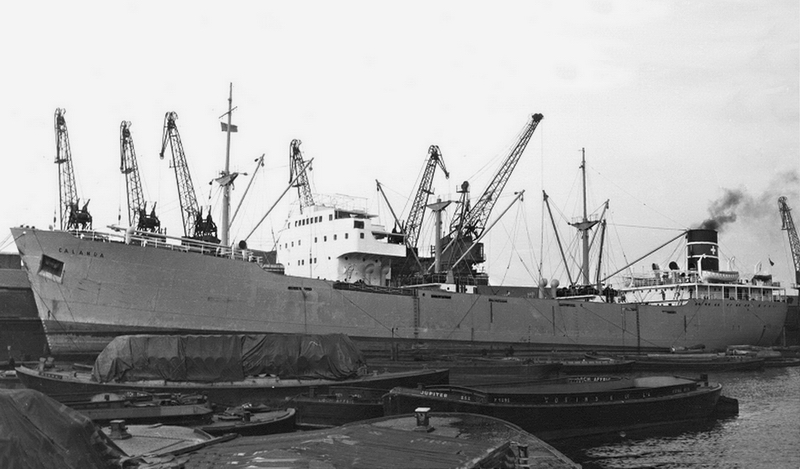
London 28.05.1952
Bildherkunft / Photosource: © Tom Rayner †
|
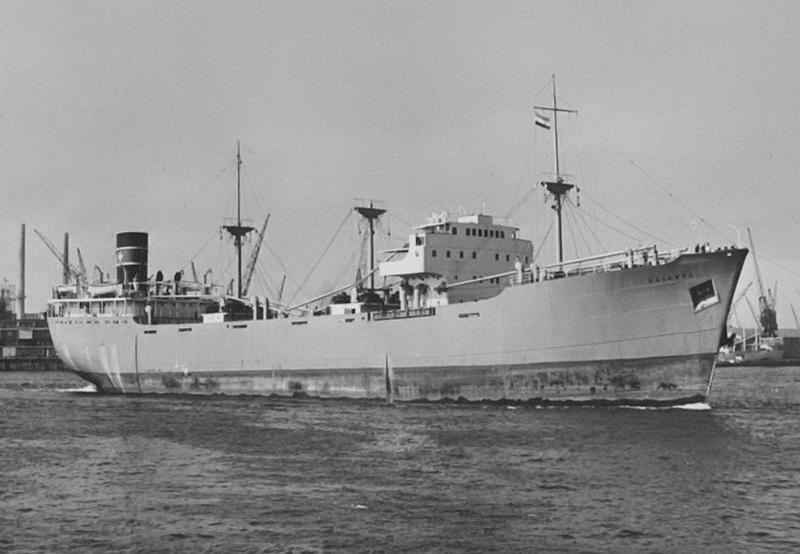
Rotterdam May 1953
Bildherkunft / Photosource: © Radio Officer Antoon Koster coll.
|
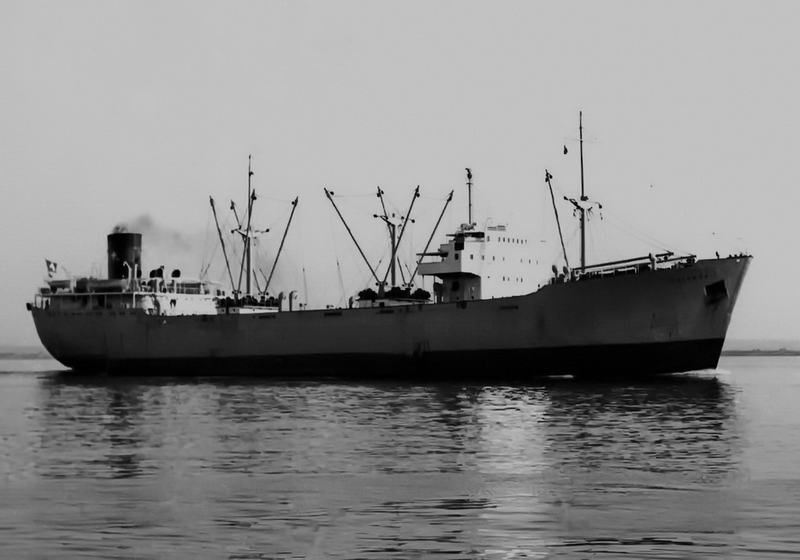
In der 1. Hälfte des Jahres 1953 wurden die weissen Streifen von der Schornsteinmarke der Schweizerischen Reederei AG (SRAG), Abteilung Seeschiffahrt, oberhalb und unterhalb vom roten Band mit Schweizerkreuz aus dem schwarzen Kamin entfernt / In the first half of 1953, the white stripes from the funnel mark of the Schweizerische Reederei AG (SRAG), Maritime Department (Swiss Shipping Ltd), above and below the red band with the Swiss cross were removed from the black stack
Bildherkunft / Photosource: © Unbekannt / Unknown / © SwissShips-Collection
|
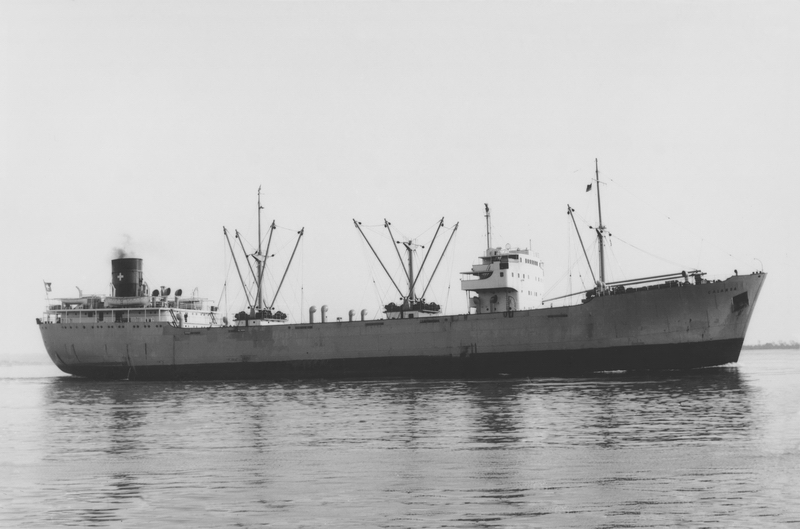
In der 1. Hälfte des Jahres 1953 wurden die weissen Streifen von der Schornsteinmarke der Schweizerischen Reederei AG (SRAG), Abteilung Seeschiffahrt, oberhalb und unterhalb vom roten Band mit Schweizerkreuz aus dem schwarzen Kamin entfernt / In the first half of 1953, the white stripes from the funnel mark of the Schweizerische Reederei AG (SRAG), Maritime Department (Swiss Shipping Ltd), above and below the red band with the Swiss cross were removed from the black stack
Bildherkunft / Photosource: © Unbekannt / Unknown / © SwissShips-Collection
|
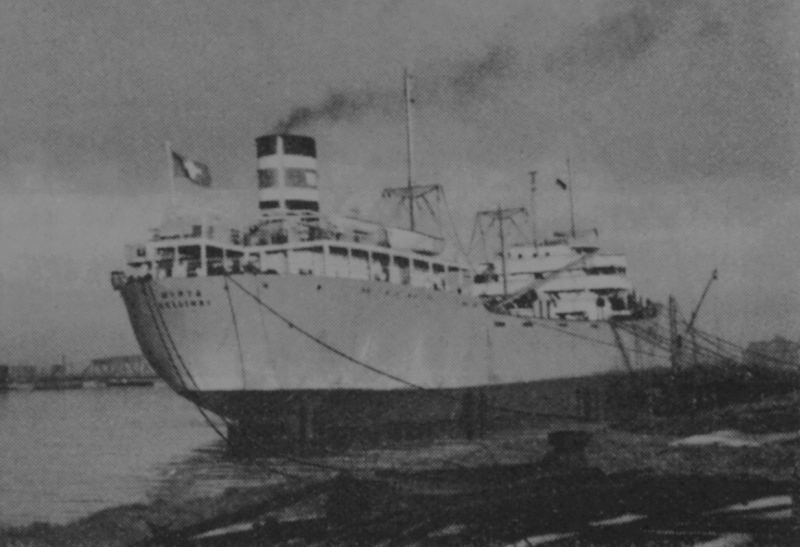
Kurz vor der Übergabe an die finnischen Eigner mit dem neuen Namen WIRTA aber noch mit Schweizer Flagge in Bremerhaven an der Werft / Shortly before the handover to the Finnish owners with the new name WIRTA but still flying the Swiss flag in Bremerhaven at the shipyard
Bildherkunft / Photosource: © SRAG (Schweizerische Reederei AG) Archiv Basel
|

Wir suchen Fotos / Photographs wanted
Bildherkunft / Photosource: © SwissShips / FotoMar
|
|
Diverse Photos
G. A. Plan
Bildherkunft / Photosource: © SRAG (Schweizerische Reederei AG) Basel
|
In Antwerpen mit Rheinschiff DAMCO 129 längseits im November 1951 beim Zement laden / In Antwerp with the Rhine ship DAMCO 129 alongside loading cement in November 1951
Bildherkunft / Photosource: © SRAG (Schweizerische Reederei AG) Archiv Basel
|
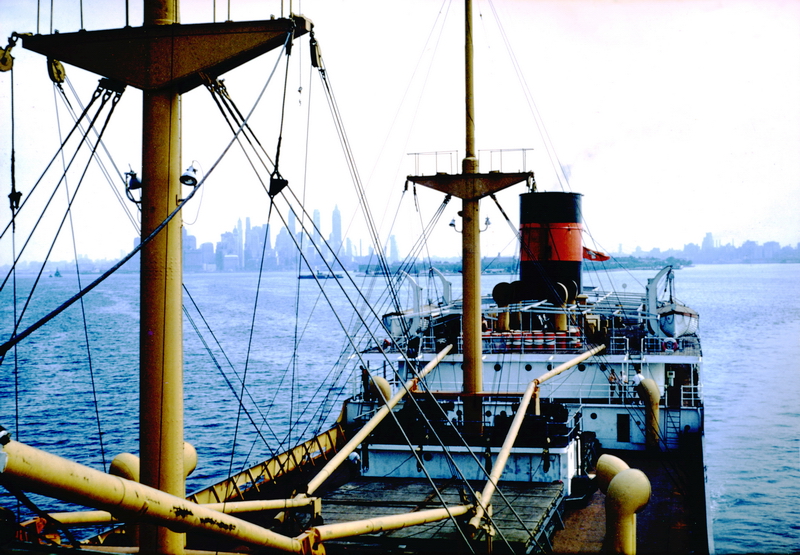
Auslaufend New York am 27. Juni 1953 / Departed New York on June 27, 1953
Bildherkunft / Photosource: Unbekannt / Unknown / © SwissShips / Archiv |
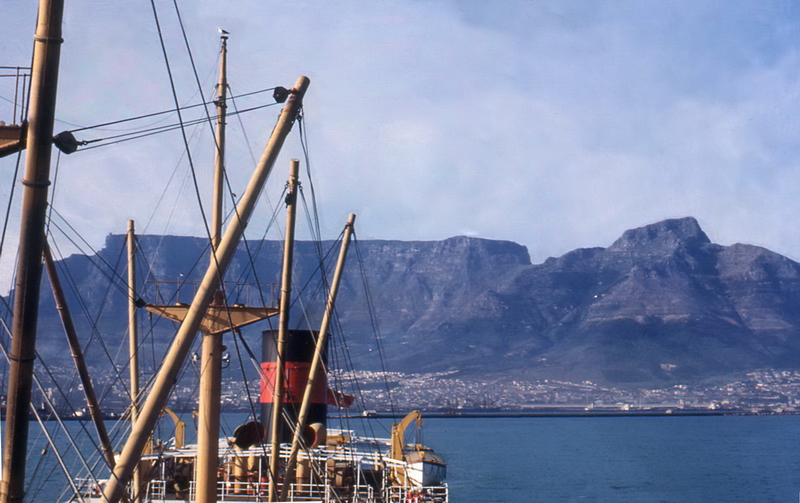
Kaapstad / Cape Town 24. August 1953
Bildherkunft / Photosource: Unbekannt / Unknown / © SwissShips / Archiv |
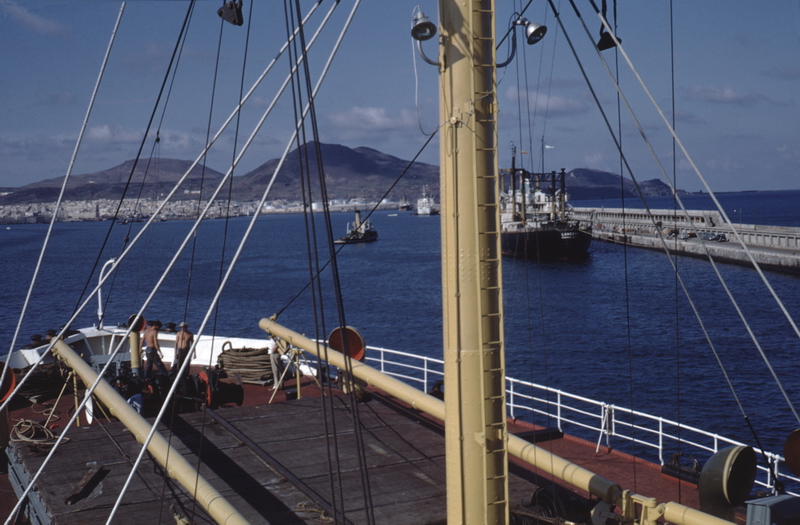
Einlaufend Las Palmas de Gran Canaria am 22. Oktober 1953 an Steuerbord S/S LANCERO aus Buenos Aires, ein ehemaliger Flugzeugträger aus dem 2. Weltkrieg
Bildherkunft / Photosource: Unbekannt / Unknown - © SwissShips / Archiv |
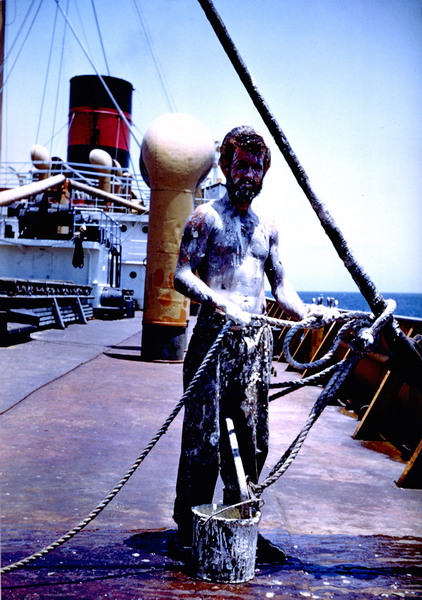
Matrose beim Mastwanten labsalben mit Bleiweiss / Sailor at the mast shrouds ointment with white lead
Bildherkunft / Photosource: Unbekannt / Unknown / © SwissShips / Archiv |
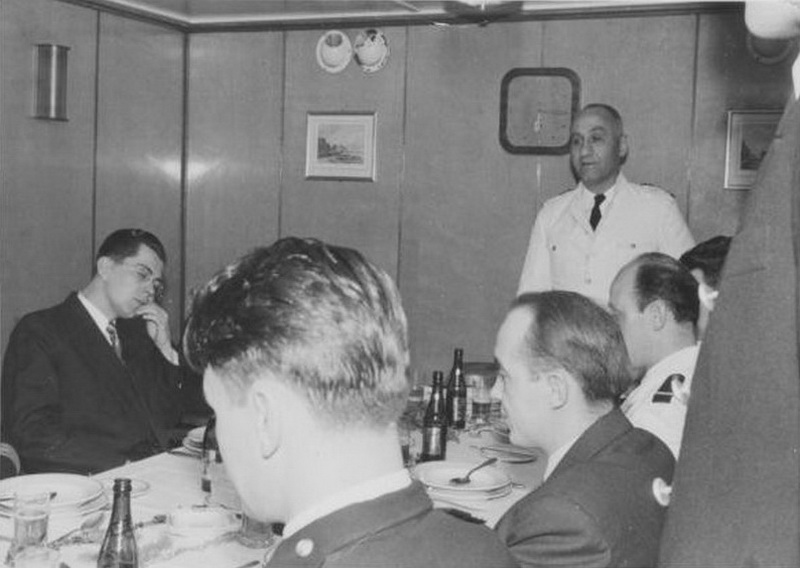
Ca. 1953 / 54 auf See, Kapitän A. Wimmel † hält die Weihnachtsrede / Around 1953/54 at sea. Captain A. Wimmel † gives the Christmas speech
Bildherkunft / Photosource: Radio Officer © Antoon Koster
|

Wir suchen Fotos / Photographs wanted
Bildherkunft / Photosource: © SwissShips / © FotoMar
|
|
vorher als / previously as
Auf der Probe - & Übergabefahrt / On seatrial and delviery voyage
Bildherkunft / Photosource: © Tyne & Wear Museums
|
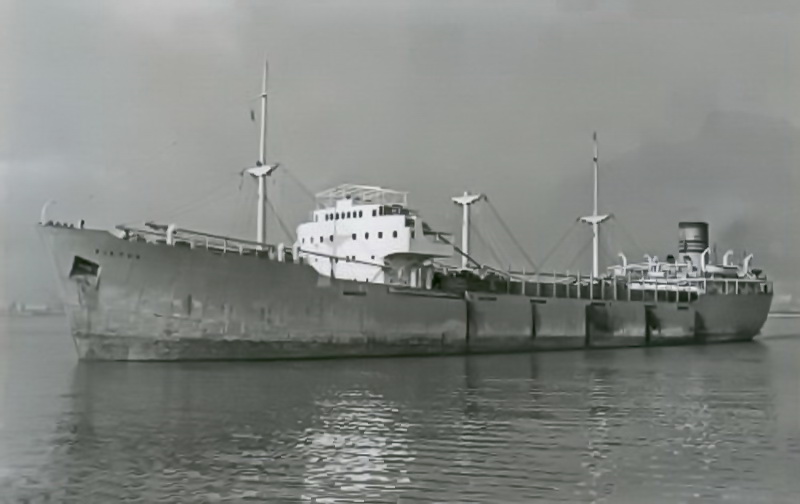
Vor Kapstadt, Südafrika / Buite Kaapstad, Suid-Afrika / Off Cape Town, South Africa
Bildherkunft / Photosource: © Unbekannt / Unknown / © SwissShips / Archiv
|

Wir suchen Fotos / Photographs wanted
Bildherkunft / Photosource: © SwissShips / © FotoMar
|
|
später als / later as
Im Nordsee Kanal bei Amsterdam / In the North Sea Canal near Amsterdam
Bildherkunft / Photosource: © G. Bunschoten† / © Krzysztof (Risto) Brzoza Collection
|
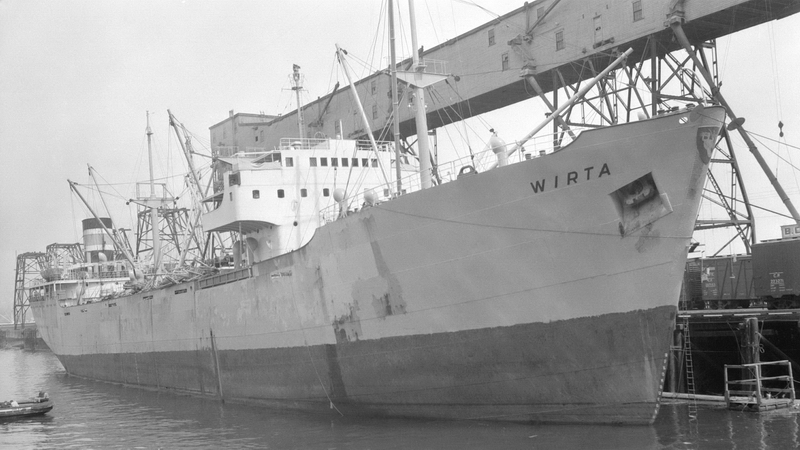
Vancouver April 30, 1958
Bildherkunft / Photosource: © Vancouver Archives Walter E. Frost (Reference code AM1506-S3-3-: CVA 447-8983.2)
|
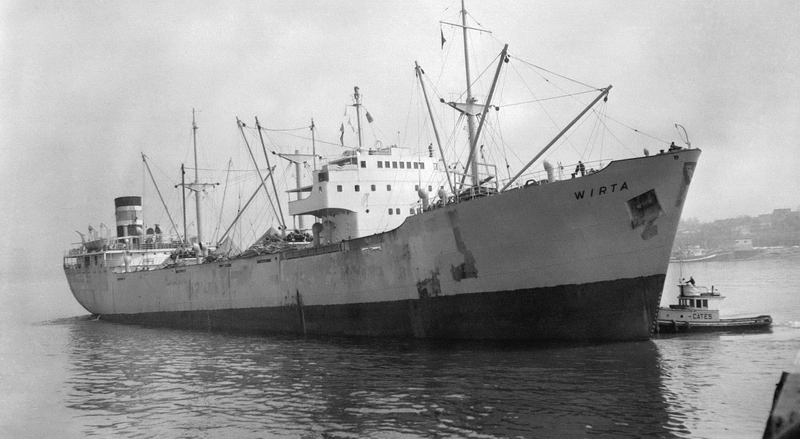
Vancouver 01.05.1958
Bildherkunft / Photosource: © Vancouver Archives Walter E. Frost (Reference code AM1506-S3-3-: CVA 447-8983.1)
|
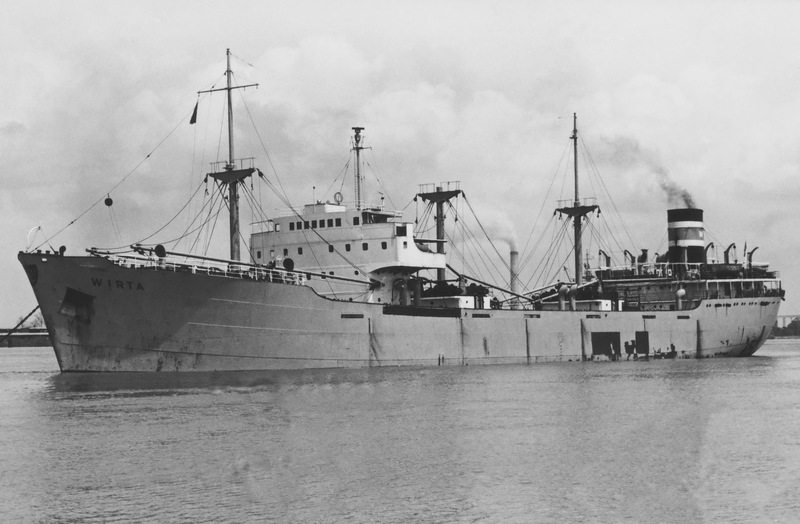
In Nordamerikanischen Gewässern / In North American waters
Bildherkunft / Photosource: © V.H. Young & L.A. Sawyer
|
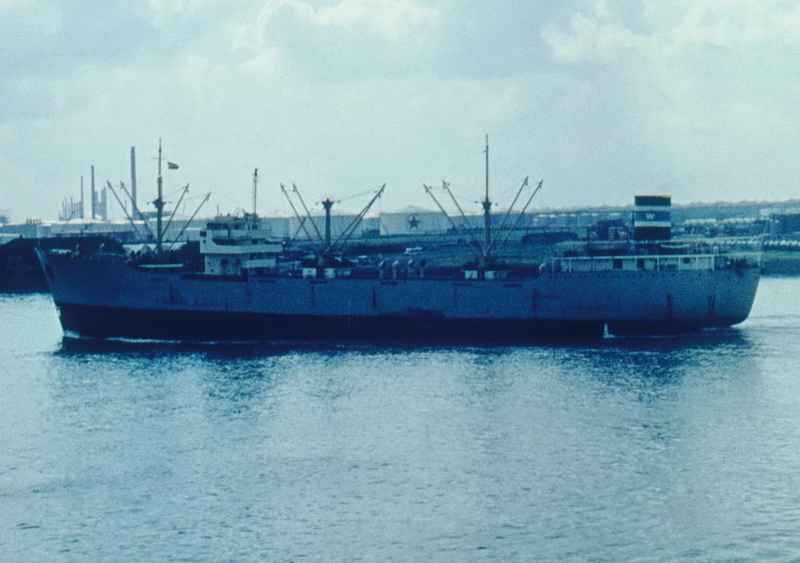
In Niederländischen Gewässern / In Dutch waters
Bildherkunft / Photosource: © SwissShips / © MB-Photo-Sammlung
|
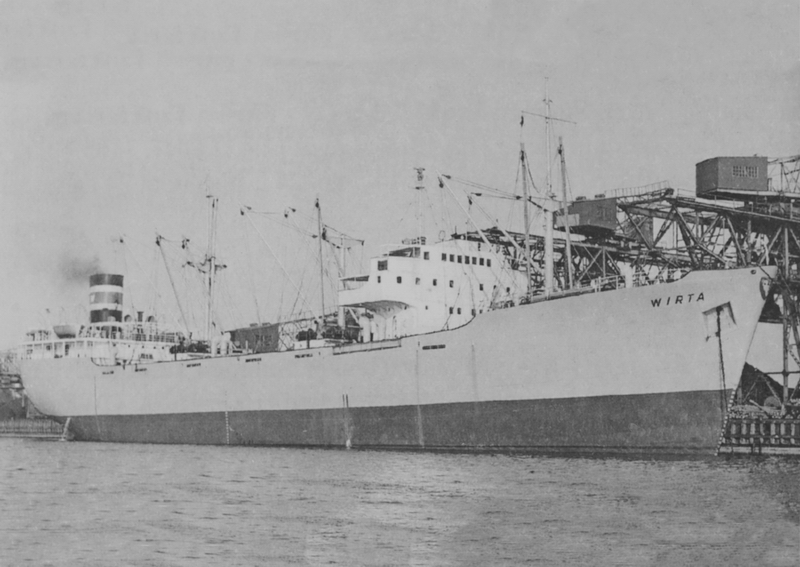
Bildherkunft / Photosource: © Unbekannt / Unknown / © SwissShips-Collection
|
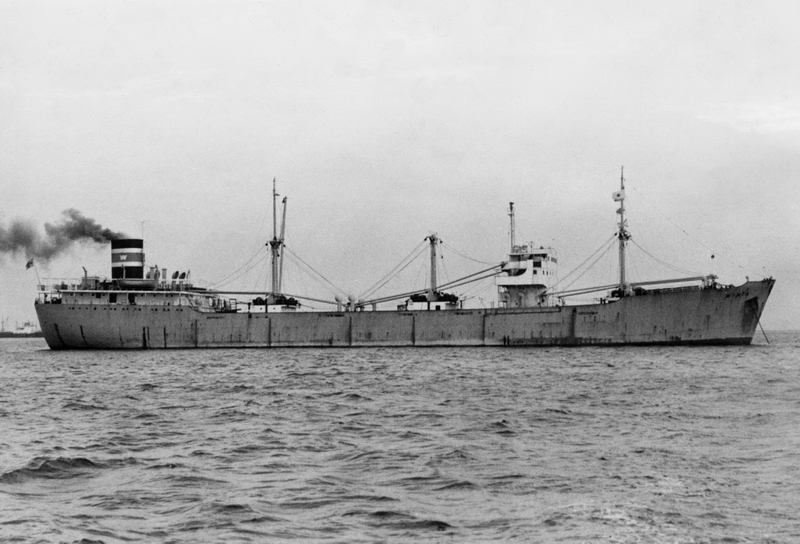
Am Anker vor Japan mit Schwergutbaum (Jumbo) beim Hauptmast / At anchor off Japan with heavy lift boom (jumbo) at the main mast
Bildherkunft / Photosource: © Kalevi Riikonen's father has sailed onboard of the WIRTA / Via © Timo Sylvïänne
|

Wir suchen Fotos / Photographs wanted
Bildherkunft / Photosource: © SwissShips / © FotoMar
|
|
später als / later as
Welland Ship Canal at Port Robinson on August 14, 1965
Bildherkunft / Photosource: © Barry Andersen, via © Harry Stott & Trevor Jones
|
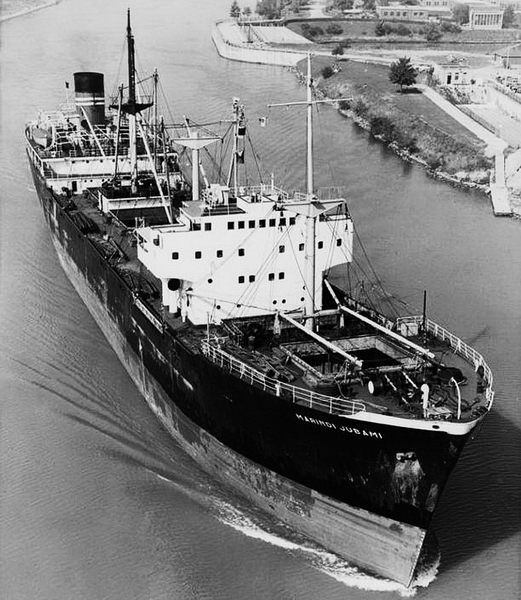
Welland Canal Seaway Great Lakes August 14, 1965
Bildherkunft / Photosource: © Unbekannt / Unknown / © SwissShips / Archiv
|
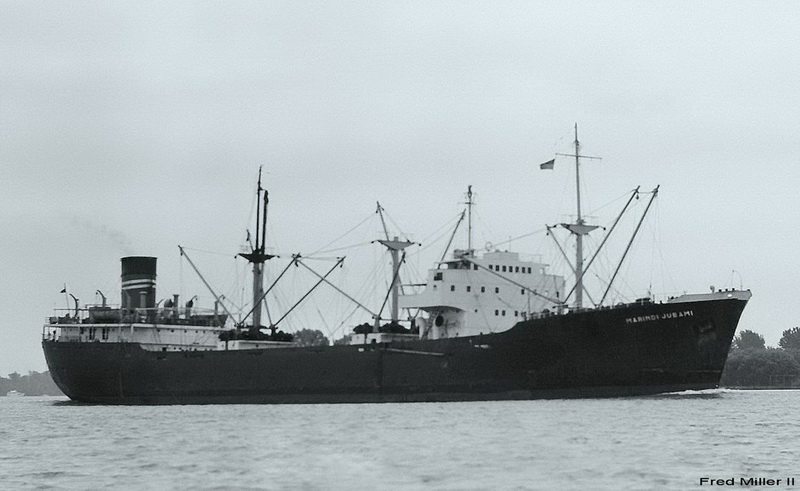
At Marine City, Michigan USA, August 30, 1965
Bildherkunft / Photosource: © Fred Miller II
|
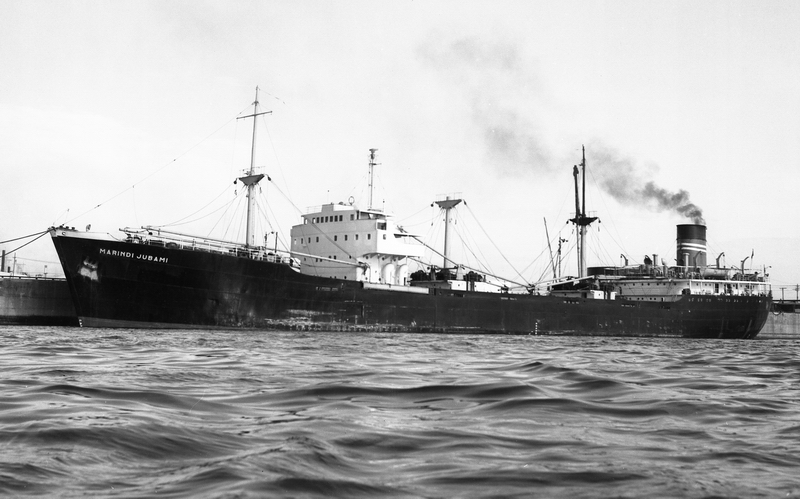
In Nordamerikanischen Gewässern / In North American waters
Bildherkunft / Photosource: © Malcolm Cranfield-Photocollection
|
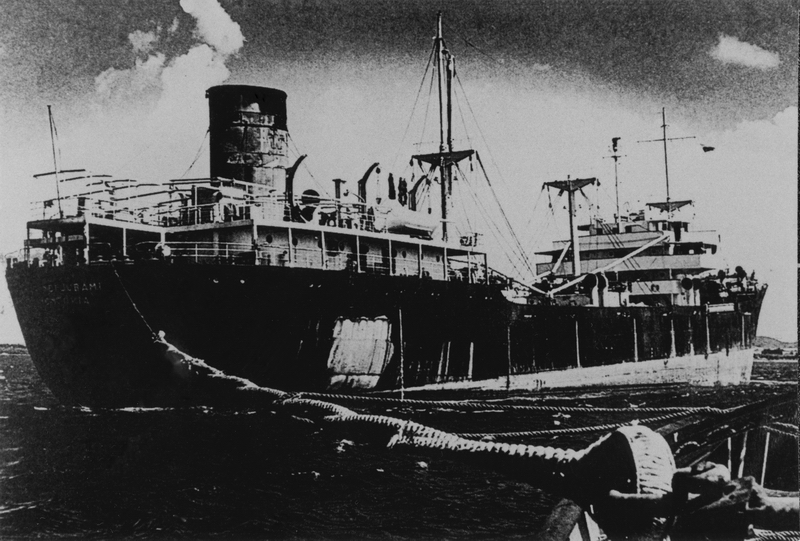
Im Schlepp in Kolumbien mit sichtbarem Feuerschaden achtern / Towing in Colombia with visible fire damage aft
Bildherkunft / Photosource: © Unbekannt / Unknown / © SwissShips / Archiv
|

Wir suchen Fotos / Photographs wanted
Bildherkunft / Photosource: © SwissShips / © FotoMar |
